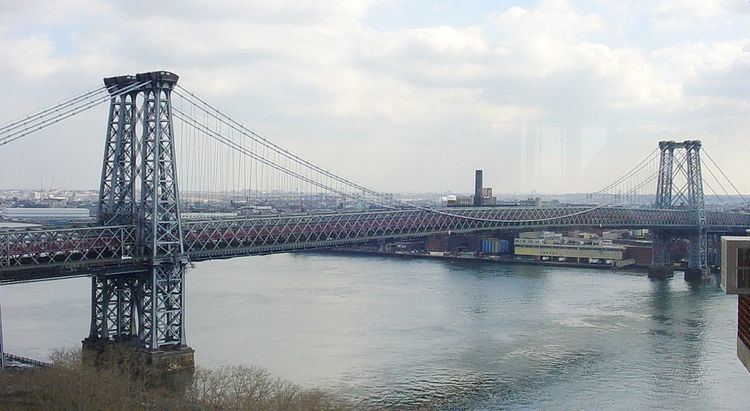Address New York, NY 11104, USA Construction started 1896 Clearance below 41 m | ID number 2240039 Total length 2,227 m Height 94 m Toll Free | |
 | ||
Carries 8 lanes of roadway,2 tracks of the trains of the New York City Subway,pedestrians, and bicycles Similar Profiles | ||
Williamsburg bridge outer roadway eastbound
The Williamsburg Bridge is a suspension bridge in New York City across the East River connecting the Lower East Side of Manhattan at Delancey Street with the Williamsburg neighborhood of Brooklyn at Broadway near the Brooklyn-Queens Expressway (Interstate 278). It once carried New York State Route 27A and was planned to carry Interstate 78, though the planned I-78 designation was aborted by the cancellation of the Lower Manhattan Expressway and Bushwick Expressway.
Contents
- Williamsburg bridge outer roadway eastbound
- Williamsburg bridge crash update
- History
- Description
- Rail tracks
- Plazas
- In popular culture
- References
This is one of four toll-free crossings between Manhattan and Long Island. The others are the Queensboro, Manhattan, and Brooklyn Bridges.
Williamsburg bridge crash update
History
Construction on the bridge, the second to cross this river, began in 1896, with Leffert L. Buck as chief engineer, Henry Hornbostel as architect and Holton D. Robinson as assistant engineer, and the bridge opened on December 19, 1903 at a cost of $24,200,000 ($624 million in 2016). At the time it was constructed, the Williamsburg Bridge set the record for the longest suspension bridge span on Earth. The record fell in 1924, when the Bear Mountain Bridge was completed.
Decades of deferred maintenance caused the bridge to deteriorate significantly; by 1988, more than 200 cables in the suspension had snapped, and pieces of concrete were falling from the bridge. The bridge's structural integrity was rated as 1.6 out of a scale of 1 to 7. Inspectors were appointed to monitor the bridge's status and make temporary bridge closures based on the amount of stress placed on the bridge. The bridge was completely shut down to motor vehicle traffic and subway trains on April 11, 1988, after a painter noticed a large hole in a girder; upon further review, inspectors also discovered severe corrosion in a floor beam. The bridge was reopened in June 1988.
The bridge was rebuilt through much of the 1990s and 2000s. The cast iron stairway on the Manhattan side, and the steep ramp from Driggs Avenue on the Williamsburg side to the footwalks, were replaced to allow handicapped access in the 1990s. Since the new bike path opened, the bridge has become the most heavily bicycled span in North America. In 1999, Gandhi Engineering designed, engineered, and installed the pedestrian bridge along the Williamsburg Bridge.
A celebration was held on June 22, 2003, to mark the 100th anniversary of the bridge and the area surrounding Continental Army Plaza was filled with musical performers, exhibits on the history of the bridge, and street vendors. Dignitaries marched across the bridge carrying the 45-star American flag used in a game of capture the flag played by workers after the placement of the final cable in June 1902. A truck-sized birthday cake was specially made for the event by Domino Sugar, which had a factory on the East River waterfront near the bridge. The bridge was designated as a National Historic Civil Engineering Landmark by the American Society of Civil Engineers in 2009.
Description
The Williamsburg Bridge has an unconventional structure among suspension bridges; though the main span hangs from cables in the usual manner, the side spans leading to the approaches are supported by trusswork, drawing no support from the cables above. The main span of the bridge is 1,600 feet (490 m) long. The entire bridge is 7,308 feet (2,227 m) long, including approaches, and the deck is 118 feet (36 m) wide. The height at the center of the bridge is 135 feet (41 m) and each tower is 310 feet (94 m), measurements being taken from the river's surface at high-water mark.
The Brooklyn landing is between Grand Street and Broadway, which both had ferries at the time. The five ferry routes operated from these landings withered and went out of business by 1908.
The bridge once carried New York State Route 27A. Had the Lower Manhattan Expressway been built, the Williamsburg Bridge would have been designated Interstate 78.
In reference to the area’s large Yiddish-speaking population, a sign on the westbound approach to the bridge reads, "Leaving Brooklyn: Oy Vey!"
Rail tracks
The Williamsburg and Manhattan bridges are the only suspension bridges in New York City that still carry both automobile and rail traffic. On the Williamsburg Bridge, there were once two sets of trolley tracks (four tracks in total), in addition to the two subway tracks currently on the bridge that connect the New York City Subway's BMT Nassau Street Line and BMT Jamaica Line.
Two tracks on the south side carried streetcars from the Brooklyn side:
Two north-side tracks carried Manhattan streetcars:
The rapid transit tracks in the center of the bridge were initially used by the Brooklyn Rapid Transit Company (BRT) elevated railroad. Today, the New York City Subway's J M Z trains, successors to the BRT/BMT lines, use these tracks at the following times:
Plazas
At the foot of the bridge in Williamsburg between South 5th Place and Havemeyer Street in Brooklyn are three public areas that, collectively, comprise the Williamsburg Bridge Plaza, also known as Washington Plaza or George Washington Monument Park. It contains Continental Army Plaza and LaGuardia Playground, both operated by the Parks Department, as well as the Williamsburg Bridge Plaza Bus Terminal, which serves numerous bus lines to Brooklyn and Queens. The plaza is named after the large statue of George Washington in Continental Army Plaza erected in 1906.
